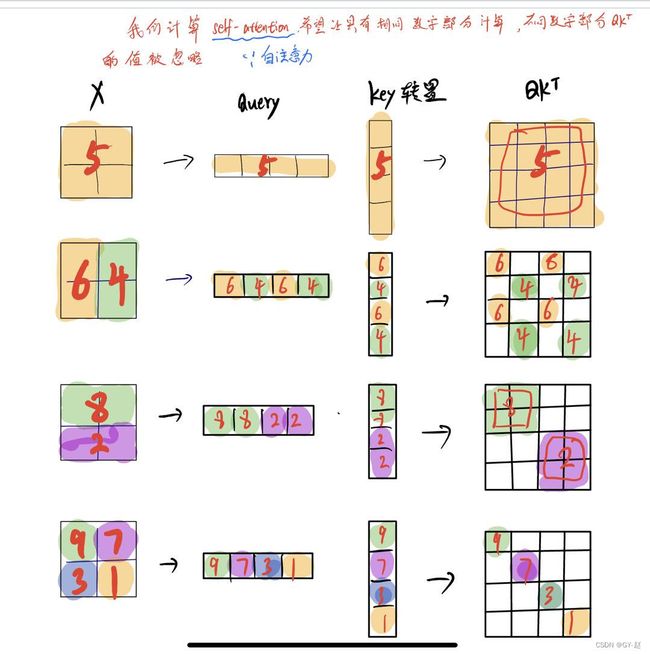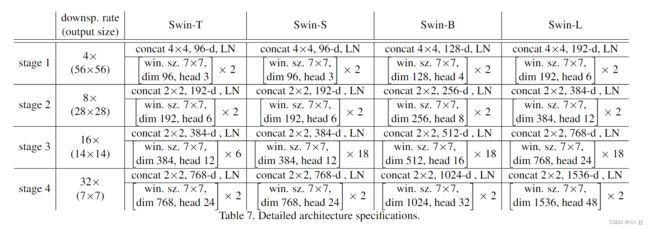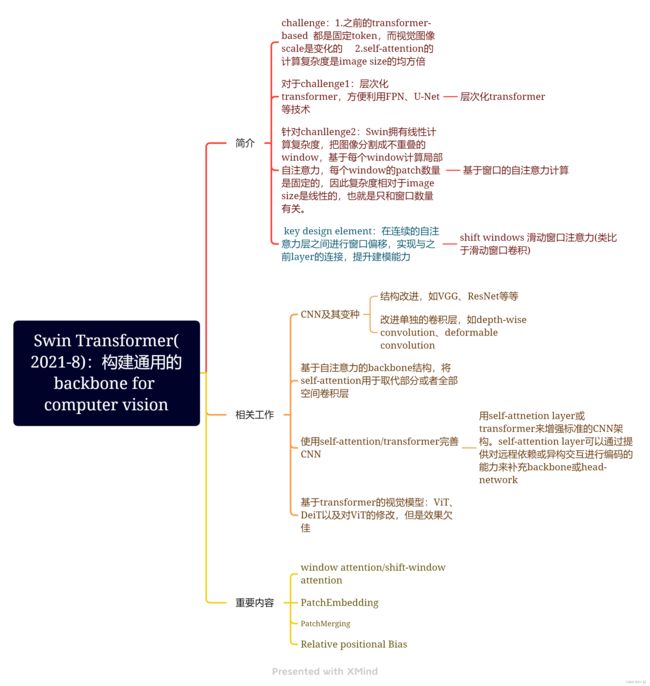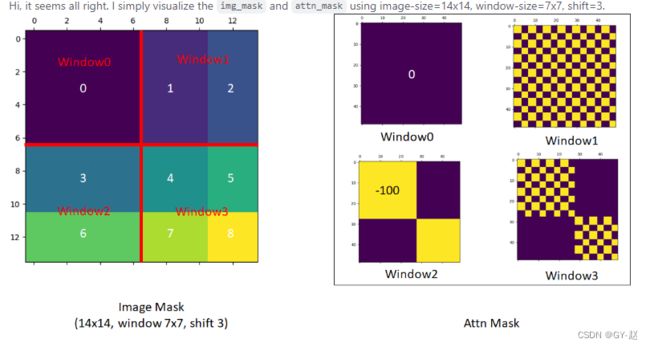Swin-Transformer(2021-08)
简介
一直到写下这篇笔记开始,基于Swin的模型仍然霸榜Object Detection等多个榜单。
很多博客都已经介绍的非常详细了,这里只记录一下自己学习过程中遇到的困惑。

Swin与ViT的对比,ViT将image划分为固定大小的patch,以patch为单位进行attention计算,计算过程中的feature map 分辨率是保持不变的,并且ViT为了保持与NLP的一致性,添加了一个额外的class token,最后用于分类。因此ViT不太适用于检测等下游任务,无法提取多尺度特征。
想要transformer用于检测等视觉任务,一种就是模仿CNN,将transformer改造为层级机构,一种就是使用纯transformer结构进行探索。
Swin显然属于前者,采用局部窗口自注意力和shift window的方式巧妙构造出了层级结构,可以作为视觉领域的通用backbone使用。

上图是Swin-T的结构图,输入图像首先通过Patch Partitiion 和Linear Embedding 转化为token形式的向量序列,然后输入Swin Transformer Block中,每个Block都是由一个window–Multi-Head self Attention 和Shift-Window Multi-head self-attention 组成,因此总是偶数。
window partition 窗口划分
将(B, H, W, C) 划分为(num_windows*B, window_size, window_size, C)的windows
def window_partition(x, window_size):
"""
Args:
x: (B, H, W, C)
window_size (int): window size
Returns:
windows: (num_windows*B, window_size, window_size, C)
"""
B, H, W, C = x.shape
x = x.view(B, H // window_size, window_size, W // window_size, window_size, C)
#view() 必须针对contiguous数据存放格式
windows = x.permute(0, 1, 3, 2, 4, 5).contiguous().view(-1, window_size, window_size, C)
return windows
#恢复原始输入 x
def window_reverse(windows, window_size, H, W):
"""
Args:
windows: (num_windows*B, window_size, window_size, C)
window_size (int): Window size
H (int): Height of image
W (int): Width of image
Returns:
x: (B, H, W, C)
"""
B = int(windows.shape[0] / (H * W / window_size / window_size))
x = windows.view(B, H // window_size, W // window_size, window_size, window_size, -1)
x = x.permute(0, 1, 3, 2, 4, 5).contiguous().view(B, H, W, -1)
return x
测试运行如下
x = torch.randn(1,224,224,3)
p =window_partition(x,7)
print(p.size())
o = window_reverse(p,7,224,224)
print(o.size())
***output
torch.Size([1024, 7, 7, 3])
torch.Size([1, 224, 224, 3])***
partition就是将输入image转换为指定window size的patch向量,这里就是将(1 ,224,224,3)的batch转换为1024个窗口尺寸为(7,7)的patch。
reverse函数是partition的反函数
PatchEmbedding
[B C H W]->[B ,Ph*Pw,96]
import torch
from torch import nn
from timm.models.layers import to_2tuple
class PatchEmbed(nn.Module):
r""" Image to Patch Embedding
Args:
img_size (int): Image size. Default: 224.
patch_size (int): Patch token size. Default: 4.
in_chans (int): Number of input image channels. Default: 3.
embed_dim (int): Number of linear projection output channels. Default: 96.
norm_layer (nn.Module, optional): Normalization layer. Default: None
"""
def __init__(self, img_size=224, patch_size=4, in_chans=3, embed_dim=96, norm_layer=None):
super().__init__()
img_size = to_2tuple(img_size) #(224,224)
patch_size = to_2tuple(patch_size) #patch size (4,4)
patches_resolution = [img_size[0] // patch_size[0], img_size[1] // patch_size[1]] #(56,56)
self.img_size = img_size
self.patch_size = patch_size
self.patches_resolution = patches_resolution #分辨率指patch数
self.num_patches = patches_resolution[0] * patches_resolution[1] #56*56=3136
self.in_chans = in_chans
self.embed_dim = embed_dim
#使用2d卷积进行patch 划分,输入channe默认为3
self.proj = nn.Conv2d(in_chans, embed_dim, kernel_size=patch_size, stride=patch_size) #output:(batch,96,56,56)
if norm_layer is not None:
self.norm = norm_layer(embed_dim)
else:
self.norm = None
def forward(self, x):
B, C, H, W = x.shape
# FIXME look at relaxing size constraints
#限制图像尺寸必须为224*224
assert H == self.img_size[0] and W == self.img_size[1], \
f"Input image size ({H}*{W}) doesn't match model ({self.img_size[0]}*{self.img_size[1]})."
#B C h W -> b embed h*w ->b h*W embed 得到 Patch Embeding 形状
x = self.proj(x) #Patch 划分 [1,96,56,56]
x=x.flatten(2).transpose(1, 2) # B Ph*Pw C
if self.norm is not None:
x = self.norm(x)
return x
def flops(self):
Ho, Wo = self.patches_resolution
flops = Ho * Wo * self.embed_dim * self.in_chans * (self.patch_size[0] * self.patch_size[1])
if self.norm is not None:
flops += Ho * Wo * self.embed_dim
return flops
x = torch.randn(1,3,224,224)
PM = PatchEmbed()
out = PM(x)
print(out.shape)
**output
torch.Size([1, 3136, 96])**
PatchMerging
[B,H*W,C]->[B,H/2,W/2,2C]
PatchMerging 相当于卷积中的下采样,降低feature map的分辨率,同时增加channel的维度,这里分辨率H,W都降为原来的一半(整体减少4倍),channel数变为原来的两倍。
class PatchMerging(nn.Module):
r""" Patch Merging Layer.
Args:
input_resolution (tuple[int]): Resolution of input feature.
dim (int): Number of input channels.
norm_layer (nn.Module, optional): Normalization layer. Default: nn.LayerNorm
"""
def __init__(self, input_resolution, dim, norm_layer=nn.LayerNorm):
super().__init__()
self.input_resolution = input_resolution
self.dim = dim
self.reduction = nn.Linear(4 * dim, 2 * dim, bias=False)
self.norm = norm_layer(4 * dim)
def forward(self, x):
"""
x: B, H*W, C
"""
H, W = self.input_resolution
B, L, C = x.shape
assert L == H * W, "input feature has wrong size" #限制输入x的第二个维度与H,W匹配
assert H % 2 == 0 and W % 2 == 0, f"x size ({H}*{W}) are not even."
x = x.view(B, H, W, C)
#按照 H W 间隔为2 ,两两组合 共4组
x0 = x[:, 0::2, 0::2, :] # B H/2 W/2 C
x1 = x[:, 1::2, 0::2, :] # B H/2 W/2 C
x2 = x[:, 0::2, 1::2, :] # B H/2 W/2 C
x3 = x[:, 1::2, 1::2, :] # B H/2 W/2 C
print("\n",x0,"\n",x1,"\n",x2,"\n",x3)
x = torch.cat([x0, x1, x2, x3], -1) # B H/2 W/2 4*C #特征图分辨率降低一半
x = x.view(B, -1, 4 * C) # B H/2*W/2 4*C 此时通道维度变为原来的4倍
x = self.norm(x)
x = self.reduction(x) #4C -> 2C 通过linear 通道维度由4倍变为原来的2倍
return x
def extra_repr(self) -> str:
return f"input_resolution={self.input_resolution}, dim={self.dim}"
def flops(self):
H, W = self.input_resolution
flops = H * W * self.dim
flops += (H // 2) * (W // 2) * 4 * self.dim * 2 * self.dim
return flops
PM = PatchMerging(input_resolution=(4,4),dim=3)
x = torch.arange(48,dtype=torch.float).view(1,16,3)
o=PM(x)
print(o.shape)
output:
***tensor([[[[ 0., 1., 2.],
[ 6., 7., 8.]],
[[24., 25., 26.],
[30., 31., 32.]]]])***
***tensor([[[[12., 13., 14.],
[18., 19., 20.]],
[[36., 37., 38.],
[42., 43., 44.]]]])***
***tensor([[[[ 3., 4., 5.],
[ 9., 10., 11.]],
[[27., 28., 29.],
[33., 34., 35.]]]])***
***tensor([[[[15., 16., 17.],
[21., 22., 23.]],
[[39., 40., 41.],
[45., 46., 47.]]]])***
**torch.Size([1, 4, 6])**
Window Attention

窗口自注意力计算,限制在一个window中,公式相比与之前的attention添加了一个额外的B-相对位置偏移(relative postional bias)


从论文给出的结果来看,采用相对位置偏置后的结果要比其它方法更好。
class WindowAttention(nn.Module):
r""" Window based multi-head self attention (W-MSA) module with relative position bias.
It supports both of shifted and non-shifted window.
Args:
dim (int): Number of input channels.
window_size (tuple[int]): The height and width of the window.
num_heads (int): Number of attention heads.
qkv_bias (bool, optional): If True, add a learnable bias to query, key, value. Default: True
qk_scale (float | None, optional): Override default qk scale of head_dim ** -0.5 if set
attn_drop (float, optional): Dropout ratio of attention weight. Default: 0.0
proj_drop (float, optional): Dropout ratio of output. Default: 0.0
"""
def __init__(self, dim, window_size, num_heads, qkv_bias=True, qk_scale=None, attn_drop=0., proj_drop=0.):
super().__init__()
self.dim = dim
self.window_size = window_size # Wh, Ww
self.num_heads = num_heads
head_dim = dim // num_heads #每个注意力头对应的维数
self.scale = qk_scale or head_dim ** -0.5 #QK^T 放缩倍数 根号D
# define a parameter table of relative position bias
#构造可学习的相对位置偏置table,长度为 (2H-1)*(2W-1)*(num_head)
self.relative_position_bias_table = nn.Parameter(
torch.zeros((2 * window_size[0] - 1) * (2 * window_size[1] - 1), num_heads)) # 2*Wh-1 * 2*Ww-1, nH
# get pair-wise relative position index for each token inside the window
#获取window中每一个token的相对位置索引对
coords_h = torch.arange(self.window_size[0]) #[0,1,2...H]
coords_w = torch.arange(self.window_size[1]) #[0,1,2...W]
# mehsgrid相当于生成一个二维坐标,利用stack将两个w*h shape的张量按dim0拼接
coords = torch.stack(torch.meshgrid([coords_h, coords_w])) #(2, Wh, Ww)
coords_flatten = torch.flatten(coords, 1) # 2, Wh*Ww 拉直为2个一维序列,方便索引
#计算相对位置索引坐标
#[2,Wh*Ww,1]-[2,1,Wh*Ww]=[2, Wh*Ww, Wh*Ww] 广播机制
relative_coords = coords_flatten[:, :, None] - coords_flatten[:, None, :]
relative_coords = relative_coords.permute(1, 2, 0).contiguous() # Wh*Ww, Wh*Ww, 2
relative_coords[:, :, 0] += self.window_size[0] - 1 # shift to start from 0
relative_coords[:, :, 1] += self.window_size[1] - 1
relative_coords[:, :, 0] *= 2 * self.window_size[1] - 1
relative_position_index = relative_coords.sum(-1) # Wh*Ww, Wh*Ww
#注册buffer保存到state_dict中作为永久变量relative_position_index保存,
# 不需要参与梯度计算,只作为索引到bias table中取值
self.register_buffer("relative_position_index", relative_position_index)
self.qkv = nn.Linear(dim, dim * 3, bias=qkv_bias)#得到Q,K,V
self.attn_drop = nn.Dropout(attn_drop)
self.proj = nn.Linear(dim, dim)
self.proj_drop = nn.Dropout(proj_drop)
trunc_normal_(self.relative_position_bias_table, std=.02) #初始化
self.softmax = nn.Softmax(dim=-1)
def forward(self, x, mask=None):
"""
Args:
x: input features with shape of (num_windows*B, N, C)
mask: (0/-inf) mask with shape of (num_windows, Wh*Ww, Wh*Ww) or None
"""
B_, N, C = x.shape
'''
x.shape = (num_windows*B, N, C) N=Wh*Ww
self.qkv(x).shape = (num_windows*B, N, 3C) 经过全连接层后,调整维度分配给Q,K,V
self.qkv(x).reshape(B_, N, 3, self.num_heads, C // self.num_heads).shape = (num_windows*B, N, 3, num_heads, C//num_heads)
self.qkv(x).reshape(B_, N, 3, self.num_heads, C // self.num_heads).permute(2, 0, 3, 1, 4).shape = (3, num_windows*B, num_heads, N, C//num_heads)
'''
qkv = self.qkv(x).reshape(B_, N, 3, self.num_heads, C // self.num_heads).permute(2, 0, 3, 1, 4) #Q,K,V
q, k, v = qkv[0], qkv[1], qkv[2] # make torchscript happy (cannot use tensor as tuple)
'''
q.shape = k.shape = v.shape = (num_windows*B, num_heads, N, C//num_heads)
N = 代表patches的数量
C//num_heads代表Q,K,V的维数
'''
q = q * self.scale #Q/sqrt(dim)
attn = (q @ k.transpose(-2, -1)) #Q*K^T
"""
attn.shape = (num_windows*B, num_heads, N, N)
"""
#相对位置偏置B,将table中的值按照 (W*H,W*H,nH)的shape排列
"""
self.relative_position_index矩阵中的所有值都是从self.relative_position_bias_table中取的
self.relative_position_index是计算出来不可学习的量
self.relative_position_index.view(-1).shape=Wh*Ww*Wh*Ww 把索引矩阵展开成一维,再到Bias Table中根据索引取值
self.relative_position_bias_table.shape = (2*Wh-1 * 2*Ww-1, nH)
xxxx.view(self.window_size[0] * self.window_size[1], self.window_size[0] * self.window_size[1], -1)
得到的值为:每个attn头对应的Wh*Ww*Wh*Ww【索引self.relative_position_index.view(-1)】长度的值,每一列对应一个attn头
"""
relative_position_bias = self.relative_position_bias_table[self.relative_position_index.view(-1)].view(
self.window_size[0] * self.window_size[1], self.window_size[0] * self.window_size[1], -1) # Wh*Ww,Wh*Ww,nH
#转换为与attention shape一致
relative_position_bias = relative_position_bias.permute(2, 0, 1).contiguous() # nH, Wh*Ww, Wh*Ww
attn = attn + relative_position_bias.unsqueeze(0) #
"""
第一个维度 广播机制 相加
attn.shape = [num_windows*B,nH, Wh*Ww, Wh*Ww]==(num_windows*B, num_heads, N, N)+[1,nH, Wh*Ww, Wh*Ww]
所有attn头共用一个索引矩阵和bias table
"""
#mask windows 部分
if mask is not None:
nW = mask.shape[0]
# attn.view(B_ // nW, nW, self.num_heads, N, N).shape = (B, num_windows, num_heads, N, N) 第一个N代表有M2个token,第二个N代表每个token要计算M2次QKT的值
# mask.unsqueeze(1).unsqueeze(0).shape = (1, num_windows, 1, N, N) 第一个N代表有M2个token,第二个N代表每个token要计算M2次QKT的值
# broadcast相加
attn = attn.view(B_ // nW, nW, self.num_heads, N, N) + mask.unsqueeze(1).unsqueeze(0)
"""
attn.view().shape = [num_windows*B//nW,nH, N, N] N=Wh*Ww即window中的patch数
attn.shape = (B, num_windows, num_heads, N, N)
"""
attn = attn.view(-1, self.num_heads, N, N)
"""
attn.shape = (num_windows*B, num_heads, N, N)
"""
attn = self.softmax(attn)
else:
attn = self.softmax(attn)
attn = self.attn_drop(attn)
x = (attn @ v).transpose(1, 2).reshape(B_, N, C) #
x = self.proj(x) #全连接
x = self.proj_drop(x) #dropout
return x # x.shape = (num_windows*B, N, C) N:窗口中所有patches的数量
def extra_repr(self) -> str:
return f'dim={self.dim}, window_size={self.window_size}, num_heads={self.num_heads}'
def flops(self, N):
# calculate flops for 1 window with token length of N
flops = 0
# qkv = self.qkv(x)
flops += N * self.dim * 3 * self.dim
# attn = (q @ k.transpose(-2, -1))
flops += self.num_heads * N * (self.dim // self.num_heads) * N
# x = (attn @ v)
flops += self.num_heads * N * N * (self.dim // self.num_heads)
# x = self.proj(x)
flops += N * self.dim * self.dim
return flops
mask shift-window 可视化

更直观的方式,有颜色的结果是需要自注意力计算保留的,其他白色部分是需要忽略(mask)的地方,可以参考从后边代码生成的结果与这个图是一致的。

#attn mask 部分测试代码
#假设输入image 为4X4大小,划分为4个window,每个window为2X2大小
input_resolution =(4,4)
window_size =2
shift_size=1 #shift_size 也就是[M/2]下取整
def window_partition(x, window_size):#[B H W C]->[BHW/(window size)^2 , window size,winsow size,C ]
"""
Args:
x: (B, H, W, C)
window_size (int): window size
Returns:
windows: (num_windows*B, window_size, window_size, C)
"""
B, H, W, C = x.shape
x = x.view(B, H // window_size, window_size, W // window_size, window_size, C)
windows = x.permute(0, 1, 3, 2, 4, 5).contiguous().view(-1, window_size, window_size, C)
return windows
if shift_size > 0:
# calculate attention mask for SW-MSA
H, W = input_resolution
img_mask = torch.zeros((1, H, W, 1)) # 1 H W 1
# 提前规划好的分片位置索引-slice(start,stop,step)
h_slices = (slice(0, -window_size),
slice(-window_size, -shift_size),
slice(-shift_size, None))
w_slices = (slice(0, -window_size),
slice(-window_size, -shift_size),
slice(-shift_size, None))
cnt = 0
for h in h_slices:
for w in w_slices:
img_mask[:, h, w, :] = cnt
cnt += 1
mask_windows = window_partition(img_mask, window_size) # nW, window_size, window_size, 1
mask_windows = mask_windows.view(-1, window_size * window_size)
attn_mask = mask_windows.unsqueeze(1) - mask_windows.unsqueeze(2)
attn_mask = attn_mask.masked_fill(attn_mask != 0, float(-100.0)).masked_fill(attn_mask == 0, float(0.0))
else:
attn_mask = None
print(attn_mask)
output
tensor([[[ 0., 0., 0., 0.],
[ 0., 0., 0., 0.],
[ 0., 0., 0., 0.],
[ 0., 0., 0., 0.]],
[[ 0., -100., 0., -100.],
[-100., 0., -100., 0.],
[ 0., -100., 0., -100.],
[-100., 0., -100., 0.]],
[[ 0., 0., -100., -100.],
[ 0., 0., -100., -100.],
[-100., -100., 0., 0.],
[-100., -100., 0., 0.]],
[[ 0., -100., -100., -100.],
[-100., 0., -100., -100.],
[-100., -100., 0., -100.],
[-100., -100., -100., 0.]]])
#mask shift window 可视化代码
import torch
import matplotlib.pyplot as plt
def window_partition(x, window_size):
"""
Args:
x: (B, H, W, C)
window_size (int): window size
Returns:
windows: (num_windows*B, window_size, window_size, C)
"""
B, H, W, C = x.shape
x = x.view(B, H // window_size, window_size, W // window_size, window_size, C)
windows = x.permute(0, 1, 3, 2, 4, 5).contiguous().view(-1, window_size, window_size, C)
return windows
window_size = 7
shift_size = 3
H, W = 14, 14
img_mask = torch.zeros((1, H, W, 1)) # 1 H W 1
h_slices = (slice(0, -window_size),
slice(-window_size, -shift_size),
slice(-shift_size, None))
w_slices = (slice(0, -window_size),
slice(-window_size, -shift_size),
slice(-shift_size, None))
cnt = 0
for h in h_slices:
for w in w_slices:
img_mask[:, h, w, :] = cnt
cnt += 1
mask_windows = window_partition(img_mask, window_size) # nW, window_size, window_size, 1
mask_windows = mask_windows.view(-1, window_size * window_size)
attn_mask = mask_windows.unsqueeze(1) - mask_windows.unsqueeze(2)
attn_mask = attn_mask.masked_fill(attn_mask != 0, float(-100.0)).masked_fill(attn_mask == 0, float(0.0))
plt.matshow(img_mask[0, :, :, 0].numpy())
plt.matshow(attn_mask[0].numpy())
plt.matshow(attn_mask[1].numpy())
plt.matshow(attn_mask[2].numpy())
plt.matshow(attn_mask[3].numpy())
plt.show()
Swin 模块实现
#SwinTransformer(BasicLayer(SwinBlock))
class SwinTransformerBlock(nn.Module):
r""" Swin Transformer Block.
Args:
dim (int): Number of input channels.
input_resolution (tuple[int]): Input resulotion.
num_heads (int): Number of attention heads.
window_size (int): Window size.
shift_size (int): Shift size for SW-MSA.
mlp_ratio (float): Ratio of mlp hidden dim to embedding dim.
qkv_bias (bool, optional): If True, add a learnable bias to query, key, value. Default: True
qk_scale (float | None, optional): Override default qk scale of head_dim ** -0.5 if set.
drop (float, optional): Dropout rate. Default: 0.0
attn_drop (float, optional): Attention dropout rate. Default: 0.0
drop_path (float, optional): Stochastic depth rate. Default: 0.0
act_layer (nn.Module, optional): Activation layer. Default: nn.GELU
norm_layer (nn.Module, optional): Normalization layer. Default: nn.LayerNorm
"""
def __init__(self, dim, input_resolution, num_heads, window_size=7, shift_size=0,
mlp_ratio=4., qkv_bias=True, qk_scale=None, drop=0., attn_drop=0., drop_path=0.,
act_layer=nn.GELU, norm_layer=nn.LayerNorm):
super().__init__()
self.dim = dim #输入通道
self.input_resolution = input_resolution #输入image 分辨率
self.num_heads = num_heads #attn头
self.window_size = window_size
self.shift_size = shift_size
self.mlp_ratio = mlp_ratio
if min(self.input_resolution) <= self.window_size:
# if window size is larger than input resolution, we don't partition windows
self.shift_size = 0
self.window_size = min(self.input_resolution)
assert 0 <= self.shift_size < self.window_size, "shift_size must in 0-window_size"
self.norm1 = norm_layer(dim)
self.attn = WindowAttention(
dim, window_size=to_2tuple(self.window_size), num_heads=num_heads,
qkv_bias=qkv_bias, qk_scale=qk_scale, attn_drop=attn_drop, proj_drop=drop)#(num_windows*B, N, C)
self.drop_path = DropPath(drop_path) if drop_path > 0. else nn.Identity()
self.norm2 = norm_layer(dim)
mlp_hidden_dim = int(dim * mlp_ratio)
self.mlp = Mlp(in_features=dim, hidden_features=mlp_hidden_dim, act_layer=act_layer, drop=drop)
if self.shift_size > 0:
# calculate attention mask for SW-MSA
H, W = self.input_resolution
img_mask = torch.zeros((1, H, W, 1)) # 1 H W 1
# 提前规划好的分片索引-slice(start,stop,step)
h_slices = (slice(0, -self.window_size),
slice(-self.window_size, -self.shift_size),
slice(-self.shift_size, None))
w_slices = (slice(0, -self.window_size),
slice(-self.window_size, -self.shift_size),
slice(-self.shift_size, None))
cnt = 0
for h in h_slices:
for w in w_slices:
img_mask[:, h, w, :] = cnt
cnt += 1
mask_windows = window_partition(img_mask, self.window_size) # nW, window_size, window_size, 1
mask_windows = mask_windows.view(-1, self.window_size * self.window_size)
attn_mask = mask_windows.unsqueeze(1) - mask_windows.unsqueeze(2)
attn_mask = attn_mask.masked_fill(attn_mask != 0, float(-100.0)).masked_fill(attn_mask == 0, float(0.0))
else:
attn_mask = None
self.register_buffer("attn_mask", attn_mask)
def forward(self, x):
H, W = self.input_resolution
B, L, C = x.shape
assert L == H * W, "input feature has wrong size"
shortcut = x
x = self.norm1(x)
x = x.view(B, H, W, C)
# cyclic shift
if self.shift_size > 0:
#图像重新组合window计算attention
shifted_x = torch.roll(x, shifts=(-self.shift_size, -self.shift_size), dims=(1, 2))
else:
shifted_x = x
# partition windows
#移动后的图像划分窗口
x_windows = window_partition(shifted_x, self.window_size) # nW*B, window_size, window_size, C
x_windows = x_windows.view(-1, self.window_size * self.window_size, C) # nW*B, window_size*window_size, C
# W-MSA/SW-MSA
attn_windows = self.attn(x_windows, mask=self.attn_mask) # nW*B, window_size*window_size, C
# merge windows
attn_windows = attn_windows.view(-1, self.window_size, self.window_size, C)
shifted_x = window_reverse(attn_windows, self.window_size, H, W) # B H' W' C
# reverse cyclic shift 计算完后还原回去
if self.shift_size > 0:
x = torch.roll(shifted_x, shifts=(self.shift_size, self.shift_size), dims=(1, 2))
else:
x = shifted_x
x = x.view(B, H * W, C)
x = shortcut + self.drop_path(x)
# FFN
x = x + self.drop_path(self.mlp(self.norm2(x)))
return x
def extra_repr(self) -> str:
return f"dim={self.dim}, input_resolution={self.input_resolution}, num_heads={self.num_heads}, " \
f"window_size={self.window_size}, shift_size={self.shift_size}, mlp_ratio={self.mlp_ratio}"
def flops(self):
flops = 0
H, W = self.input_resolution
# norm1
flops += self.dim * H * W
# W-MSA/SW-MSA
nW = H * W / self.window_size / self.window_size
flops += nW * self.attn.flops(self.window_size * self.window_size)
# mlp
flops += 2 * H * W * self.dim * self.dim * self.mlp_ratio
# norm2
flops += self.dim * H * W
return flops
class PatchMerging(nn.Module): #[B H W C]->[B H/4 W/4 2C]
r""" Patch Merging Layer.
Args:
input_resolution (tuple[int]): Resolution of input feature.
dim (int): Number of input channels.
norm_layer (nn.Module, optional): Normalization layer. Default: nn.LayerNorm
"""
def __init__(self, input_resolution, dim, norm_layer=nn.LayerNorm):
super().__init__()
self.input_resolution = input_resolution
self.dim = dim
self.reduction = nn.Linear(4 * dim, 2 * dim, bias=False)
self.norm = norm_layer(4 * dim)
def forward(self, x):
"""
x: B, H*W, C
"""
H, W = self.input_resolution
B, L, C = x.shape
assert L == H * W, "input feature has wrong size"
assert H % 2 == 0 and W % 2 == 0, f"x size ({H}*{W}) are not even."
x = x.view(B, H, W, C)
#H,W 以2为间隔取数
x0 = x[:, 0::2, 0::2, :] # B H/2 W/2 C
x1 = x[:, 1::2, 0::2, :] # B H/2 W/2 C
x2 = x[:, 0::2, 1::2, :] # B H/2 W/2 C
x3 = x[:, 1::2, 1::2, :] # B H/2 W/2 C
x = torch.cat([x0, x1, x2, x3], -1) # B H/2 W/2 4*C
x = x.view(B, -1, 4 * C) # B H/2*W/2 4*C
x = self.norm(x)
x = self.reduction(x)
return x
def extra_repr(self) -> str:
return f"input_resolution={self.input_resolution}, dim={self.dim}"
def flops(self):
H, W = self.input_resolution
flops = H * W * self.dim
flops += (H // 2) * (W // 2) * 4 * self.dim * 2 * self.dim
return flops
#SwinTransformer(BasicLayer(SwinBlock))
class BasicLayer(nn.Module):
""" A basic Swin Transformer layer for one stage.
Args:
dim (int): Number of input channels.
input_resolution (tuple[int]): Input resolution.
depth (int): Number of blocks.
num_heads (int): Number of attention heads.
window_size (int): Local window size.
mlp_ratio (float): Ratio of mlp hidden dim to embedding dim.
qkv_bias (bool, optional): If True, add a learnable bias to query, key, value. Default: True
qk_scale (float | None, optional): Override default qk scale of head_dim ** -0.5 if set.
drop (float, optional): Dropout rate. Default: 0.0
attn_drop (float, optional): Attention dropout rate. Default: 0.0
drop_path (float | tuple[float], optional): Stochastic depth rate. Default: 0.0
norm_layer (nn.Module, optional): Normalization layer. Default: nn.LayerNorm
downsample (nn.Module | None, optional): Downsample layer at the end of the layer. Default: None
use_checkpoint (bool): Whether to use checkpointing to save memory. Default: False.
"""
def __init__(self, dim, input_resolution, depth, num_heads, window_size,
mlp_ratio=4., qkv_bias=True, qk_scale=None, drop=0., attn_drop=0.,
drop_path=0., norm_layer=nn.LayerNorm, downsample=None, use_checkpoint=False):
super().__init__()
self.dim = dim
self.input_resolution = input_resolution
self.depth = depth
self.use_checkpoint = use_checkpoint
# build blocks
self.blocks = nn.ModuleList([
SwinTransformerBlock(dim=dim,
input_resolution=input_resolution,
num_heads=num_heads,
window_size=window_size,
shift_size=0 if (i % 2 == 0) else window_size // 2, # 整除2为0表示W-MSA,否则shift-size决定是否SW-MSA
mlp_ratio=mlp_ratio,
qkv_bias=qkv_bias,
qk_scale=qk_scale,
drop=drop, attn_drop=attn_drop,
drop_path=drop_path[i] if isinstance(drop_path, list) else drop_path,
norm_layer=norm_layer)
for i in range(depth)]) #每个transformer block是偶数,depth对应stage遍历W-MSA/SW-MSA,如[2,2,6,2]
# patch merging layer
if downsample is not None:
self.downsample = downsample(input_resolution, dim=dim, norm_layer=norm_layer)
else:
self.downsample = None
def forward(self, x):
for blk in self.blocks:
if self.use_checkpoint:
x = checkpoint.checkpoint(blk, x)
else:
x = blk(x)
if self.downsample is not None:
x = self.downsample(x)
return x
def extra_repr(self) -> str:
return f"dim={self.dim}, input_resolution={self.input_resolution}, depth={self.depth}"
def flops(self):
flops = 0
for blk in self.blocks:
flops += blk.flops()
if self.downsample is not None:
flops += self.downsample.flops()
return flops
class PatchEmbed(nn.Module):
r""" Image to Patch Embedding
Args:
img_size (int): Image size. Default: 224.
patch_size (int): Patch token size. Default: 4.
in_chans (int): Number of input image channels. Default: 3.
embed_dim (int): Number of linear projection output channels. Default: 96.
norm_layer (nn.Module, optional): Normalization layer. Default: None
"""
def __init__(self, img_size=224, patch_size=4, in_chans=3, embed_dim=96, norm_layer=None):
super().__init__()
img_size = to_2tuple(img_size)
patch_size = to_2tuple(patch_size)
patches_resolution = [img_size[0] // patch_size[0], img_size[1] // patch_size[1]]
self.img_size = img_size
self.patch_size = patch_size
self.patches_resolution = patches_resolution
self.num_patches = patches_resolution[0] * patches_resolution[1]
self.in_chans = in_chans
self.embed_dim = embed_dim
#使用卷积进行patch 划分
self.proj = nn.Conv2d(in_chans, embed_dim, kernel_size=patch_size, stride=patch_size)
if norm_layer is not None:
self.norm = norm_layer(embed_dim)
else:
self.norm = None
def forward(self, x):
B, C, H, W = x.shape
# FIXME look at relaxing size constraints
assert H == self.img_size[0] and W == self.img_size[1], \
f"Input image size ({H}*{W}) doesn't match model ({self.img_size[0]}*{self.img_size[1]})."
#B C (h W ) -> b c h*w ->b h*W c 得到 Patch Embeding 形状
x = self.proj(x).flatten(2).transpose(1, 2) # B Ph*Pw C
if self.norm is not None:
x = self.norm(x)
return x
def flops(self):
Ho, Wo = self.patches_resolution
flops = Ho * Wo * self.embed_dim * self.in_chans * (self.patch_size[0] * self.patch_size[1])
if self.norm is not None:
flops += Ho * Wo * self.embed_dim
return flops
#SwinTransformer(BasicLayer(SwinBlock))
class SwinTransformer(nn.Module):
r""" Swin Transformer
A PyTorch impl of : `Swin Transformer: Hierarchical Vision Transformer using Shifted Windows` -
https://arxiv.org/pdf/2103.14030
Args:
img_size (int | tuple(int)): Input image size. Default 224
patch_size (int | tuple(int)): Patch size. Default: 4
in_chans (int): Number of input image channels. Default: 3
num_classes (int): Number of classes for classification head. Default: 1000
embed_dim (int): Patch embedding dimension. Default: 96
depths (tuple(int)): Depth of each Swin Transformer layer.
num_heads (tuple(int)): Number of attention heads in different layers.
window_size (int): Window size. Default: 7
mlp_ratio (float): Ratio of mlp hidden dim to embedding dim. Default: 4
qkv_bias (bool): If True, add a learnable bias to query, key, value. Default: True
qk_scale (float): Override default qk scale of head_dim ** -0.5 if set. Default: None
drop_rate (float): Dropout rate. Default: 0
attn_drop_rate (float): Attention dropout rate. Default: 0
drop_path_rate (float): Stochastic depth rate. Default: 0.1
norm_layer (nn.Module): Normalization layer. Default: nn.LayerNorm.
ape (bool): If True, add absolute position embedding to the patch embedding. Default: False
patch_norm (bool): If True, add normalization after patch embedding. Default: True
use_checkpoint (bool): Whether to use checkpointing to save memory. Default: False
"""
def __init__(self, img_size=224, patch_size=4, in_chans=3, num_classes=1000,
embed_dim=96, depths=[2, 2, 6, 2], num_heads=[3, 6, 12, 24],
window_size=7, mlp_ratio=4., qkv_bias=True, qk_scale=None,
drop_rate=0., attn_drop_rate=0., drop_path_rate=0.1,
norm_layer=nn.LayerNorm, ape=False, patch_norm=True,
use_checkpoint=False, **kwargs):
super().__init__()
self.num_classes = num_classes
self.num_layers = len(depths)
self.embed_dim = embed_dim
self.ape = ape
self.patch_norm = patch_norm
#satge4 输出的channel 8C
self.num_features = int(embed_dim * 2 ** (self.num_layers - 1)) # embed_dim*8
self.mlp_ratio = mlp_ratio
# split image into non-overlapping patches
self.patch_embed = PatchEmbed(
img_size=img_size, patch_size=patch_size, in_chans=in_chans, embed_dim=embed_dim,
norm_layer=norm_layer if self.patch_norm else None)
num_patches = self.patch_embed.num_patches
patches_resolution = self.patch_embed.patches_resolution
self.patches_resolution = patches_resolution
# absolute position embedding--ape
if self.ape:
self.absolute_pos_embed = nn.Parameter(torch.zeros(1, num_patches, embed_dim))
trunc_normal_(self.absolute_pos_embed, std=.02)
self.pos_drop = nn.Dropout(p=drop_rate)
# stochastic depth droprate:0->drop_path_rate
dpr = [x.item() for x in torch.linspace(0, drop_path_rate, sum(depths))] # stochastic depth decay rule
# build layers
self.layers = nn.ModuleList()
for i_layer in range(self.num_layers): #4
#layer 整个网络处理过程
layer = BasicLayer(dim=int(embed_dim * 2 ** i_layer), #stage输出维度:c 2c 4c 8c
input_resolution=(patches_resolution[0] // (2 ** i_layer),
patches_resolution[1] // (2 ** i_layer)),
depth=depths[i_layer],
num_heads=num_heads[i_layer],
window_size=window_size,
mlp_ratio=self.mlp_ratio,
qkv_bias=qkv_bias, qk_scale=qk_scale,
drop=drop_rate, attn_drop=attn_drop_rate,
drop_path=dpr[sum(depths[:i_layer]):sum(depths[:i_layer + 1])],
norm_layer=norm_layer,
downsample=PatchMerging if (i_layer < self.num_layers - 1) else None,
use_checkpoint=use_checkpoint)
self.layers.append(layer)
self.norm = norm_layer(self.num_features)
self.avgpool = nn.AdaptiveAvgPool1d(1)
self.head = nn.Linear(self.num_features, num_classes) if num_classes > 0 else nn.Identity()
self.apply(self._init_weights)
#参数初始化函数
def _init_weights(self, m):
if isinstance(m, nn.Linear):
trunc_normal_(m.weight, std=.02)
if isinstance(m, nn.Linear) and m.bias is not None:
nn.init.constant_(m.bias, 0)
elif isinstance(m, nn.LayerNorm):
nn.init.constant_(m.bias, 0)
nn.init.constant_(m.weight, 1.0)
@torch.jit.ignore
def no_weight_decay(self):
return {'absolute_pos_embed'}
@torch.jit.ignore
def no_weight_decay_keywords(self):
return {'relative_position_bias_table'}
def forward_features(self, x):
x = self.patch_embed(x)
if self.ape:
x = x + self.absolute_pos_embed
x = self.pos_drop(x)
for layer in self.layers:
x = layer(x)
x = self.norm(x) # B L C
x = self.avgpool(x.transpose(1, 2)) # B C 1
x = torch.flatten(x, 1)
return x
def forward(self, x):
x = self.forward_features(x)
x = self.head(x) #应该是用来分类
return x
def flops(self):
flops = 0
flops += self.patch_embed.flops()
for i, layer in enumerate(self.layers):
flops += layer.flops()
flops += self.num_features * self.patches_resolution[0] * self.patches_resolution[1] // (2 ** self.num_layers)
flops += self.num_features * self.num_classes
return flops
Swin-X 参数配置列表
 包含关系:Swin_transformer(Basic_layer(Swin_Block))
包含关系:Swin_transformer(Basic_layer(Swin_Block))
复杂度分析
reference(推荐阅读):
1.https://zhuanlan.zhihu.com/p/367111046
2. https://hub.fastgit.xyz/microsoft/Swin-Transformer/issues/38
3. https://zhuanlan.zhihu.com/p/430047908 -很清楚
4. https://blog.csdn.net/qq_37541097/article/details/121119988
5. https://blog.csdn.net/qq_39478403/article/details/120042232


